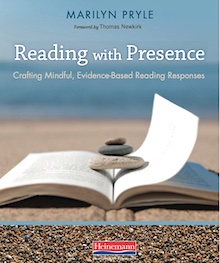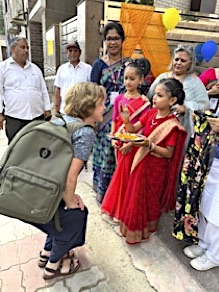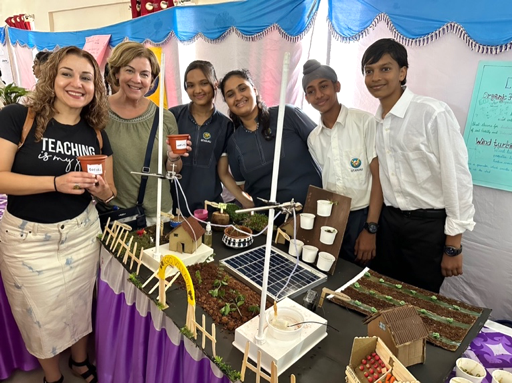3 Things India Is Getting Right about Education
By Marilyn Pryle

I worked online with teachers around the United States to create lesson plans, collaborative activities and, ultimately, a unit plan about global issues. in my case, the lessons centered around the United Nation’s Sustainable Development Goals (SDGs).
(To see the Global Education Guide that I created as my capstone project, including my unit plan, click here. To see Fulbright’s resource page of Global Education Guides from all past participants, click here.)
Passage to India
Once we completed our coursework, we were assigned in small groups of about 15-20 to various field experiences. The international assignments include countries such as Peru, Senegal, Finland, Columbia, and India.
In July, I traveled from the U.S. to Delhi with 14 other teachers. We stayed in Delhi for a week, and then were broken into smaller groups to travel to a second destination for another week. I was sent to Hyderabad. From there, we returned to Delhi and came together in our original larger group to debrief. (We also journeyed to the Taj Mahal, which was a once-in-a-lifetime experience for most of us!)
In Delhi, we observed schools and classrooms at all levels. We met several Indian teachers and got to talk to them about their work. We even met Atishi Marlena, the Minister of Education in Delhi. India has 28 states, and each has its own Minister of Education. The structure is similar to the U.S. – although there is a national education department, the states in India have the most decision-making power for their public schools.
In Hyderabad, another U.S. teacher and I were assigned to the Gitanjali Senior School, a private secondary school. India has both public and private schools, similar to the U.S. Under the guidance of our host teacher, Deepa Mathur, we observed lots of classes, met the other teachers, and toured the city. It was an amazing experience.
3 Things Schools in India Do Better
We also visited the American Consulate in Hyderabad, where we met with David Moyer, a Public Affairs Officer there. He explained to us that there are currently about 200,000 Indian students on student visas in the U.S.
These visas are for seven years – four to attend college, and an additional three to become well-exposed to American efficiency and our streamlined way of doing things. The goal is to have Indian students return to India with acquired knowledge, practice, and expertise to help the country advance where needed.
I was fascinated by this, but during my visit, I continuously noted things that some schools in India are doing better than schools in the U.S. Our cohort discussed this at length, and we continue to think about how we could incorporate more of these elements into our own schools and classrooms. Here are my top three takeaways:
1. Arts and STEM are integrated constantly and seamlessly
We saw this again and again. Music, dancing, acting, drawing, and singing were interwoven into daily lessons, school-level assemblies, and community events. On our first day in Hyderabad, we attended the Gitanjali Senior School’s Science Fair. The opening ceremony included a dance about humans and our need to study science, and another dance that acted out the spectrum of evolution.
At the fair itself, several students had written songs to explain their projects; they sang these to attendees who stopped to learn. The science projects were nuanced and carefully researched – they were top quality intellectual experiments that focused on sustainability. Including the arts only enhanced the effects.
During a school-wide assembly later in the week, we saw twelfth-grade students perform several skits they had written and rehearsed around the topic of mental health, and how it affects students. One was about social media, one was about the pressure of the final exam required for graduation, and one was about peer pressure. The props were creative and the acting was sincere.
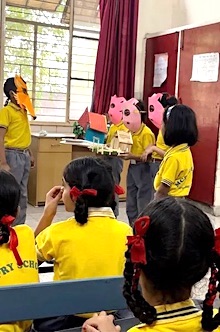
We popped into a classroom for a performance of The Three Little Pigs and then a meeting with their teachers about best practices.
In Delhi, we saw elementary students perform traditional Indian dances to welcome us, and at a school for the hard-of-hearing, students had made craft decorations and gifts. Another school had a store within the school for students to sell handiworks they had made in their art classes. Operating the store, and managing one’s own products, was part of the small-business club.
Much of this is indeed cultural—the arts are an integral part of broader Indian culture in a way that we don’t really have in the U.S. But that doesn’t mean we can’t keep trying.
In the U.S., we feel that STEM is more “serious” and “important” than the arts. We think STEM fields equal “real jobs.” But what I saw in India, especially in Hyderabad – the so-called “Silicon Valley” of India – was that we can have both, and that arts actually deepen factual knowledge in a way that rote learning cannot.
2. SEL is a deliberate focus
In Delhi, we learned that the state had recently created a Happiness Curriculum to be taught in all schools. The curriculum consists of brief activities, tailored for each grade level, to help the students focus on their mental health. Activities center around mindfulness and reflection, and include journaling, drawing, and discussion.
There are three units: Exploring Happiness through Learning and Awareness; Experiencing Happiness in Relationships through Feelings; and Happiness through Active Participation. In an elementary classroom we visited, students were drawing pictures of what makes them happy in their lives.
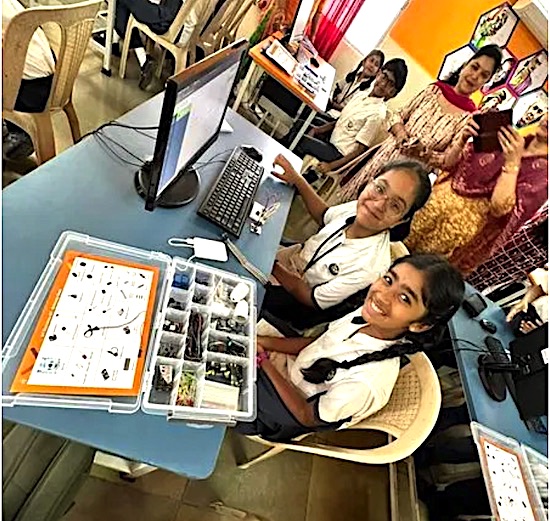
Many of the issues India educators are trying to address – including gender equality – are global issues that all countries must face.
Of course, many American teachers do activities like these. The difference is that in Delhi, it is part of the state-mandated curriculum. The state education system there recognized the social and emotional needs of its children and responded. (See here to read more about this initiative.)
I was incredibly impressed by this, not only because of the care for the whole child that it demonstrates, but because Delhi also perceives social-emotional learning – and good mental health – as a prerequisite for participating in a global world.
In addition to the official curriculum, we saw mental health activities naturally included in the school day. One school in Delhi had students practicing yoga for the first few minutes of school each day. In Hyderabad, we witnessed actual recess, at the elementary and secondary levels! Students played games and sports in everyday settings (not as official team competitors) in the middle of the day.
In addition, mandatory after-school clubs included singing, traditional dance, rollerblading, sketching, and karate—all fun things in a low-pressure setting, freely joined by all genders. We can learn from this.
3. Teachers are revered
This is a foundational part of Indian culture, and it was wonderful to experience. All of us felt appreciated and respected. Every school we went to presented us with gifts, sweets, and blessings.
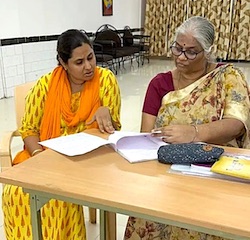
This gratitude is deeply cultural, and not something I expect to see in the U.S. in the same way. But we must shift our perception of education and teachers. Ultimately, education prepares students to be better citizens and humans; it helps us evolve intellectually, mentally, socially, and spiritually. Teachers play an integral part in this.
The ancient human practice of one person passing on knowledge and wisdom to another is indeed a sacred contract, one that should not be marred by the politics of the moment or a fear of knowing.
Toward a More Global Education
I realize that India is different from the U.S. in many ways, and that India has many specific problems, including poverty, rural areas that are extremely remote, and the caste system, to name a few. But many of the issues they are trying to address – sustainability, mental health, religious tolerance, gender equality – are global issues that all countries must face.

The holistic approach to education that I witnessed in India, one that incorporates intellectual, mental, emotional, social, and spiritual elements, can help students grow in a way that our compartmentalized U.S. system does not.
Disclaimer: “This article is not an official U.S. Department of State article. The views and information presented are the participant’s own and do not represent the Fulbright Teachers for Global Classrooms Program, the U.S. Department of State, or IREX.”
Read Marilyn’s Fulbright blog (with lots more pictures) here.
